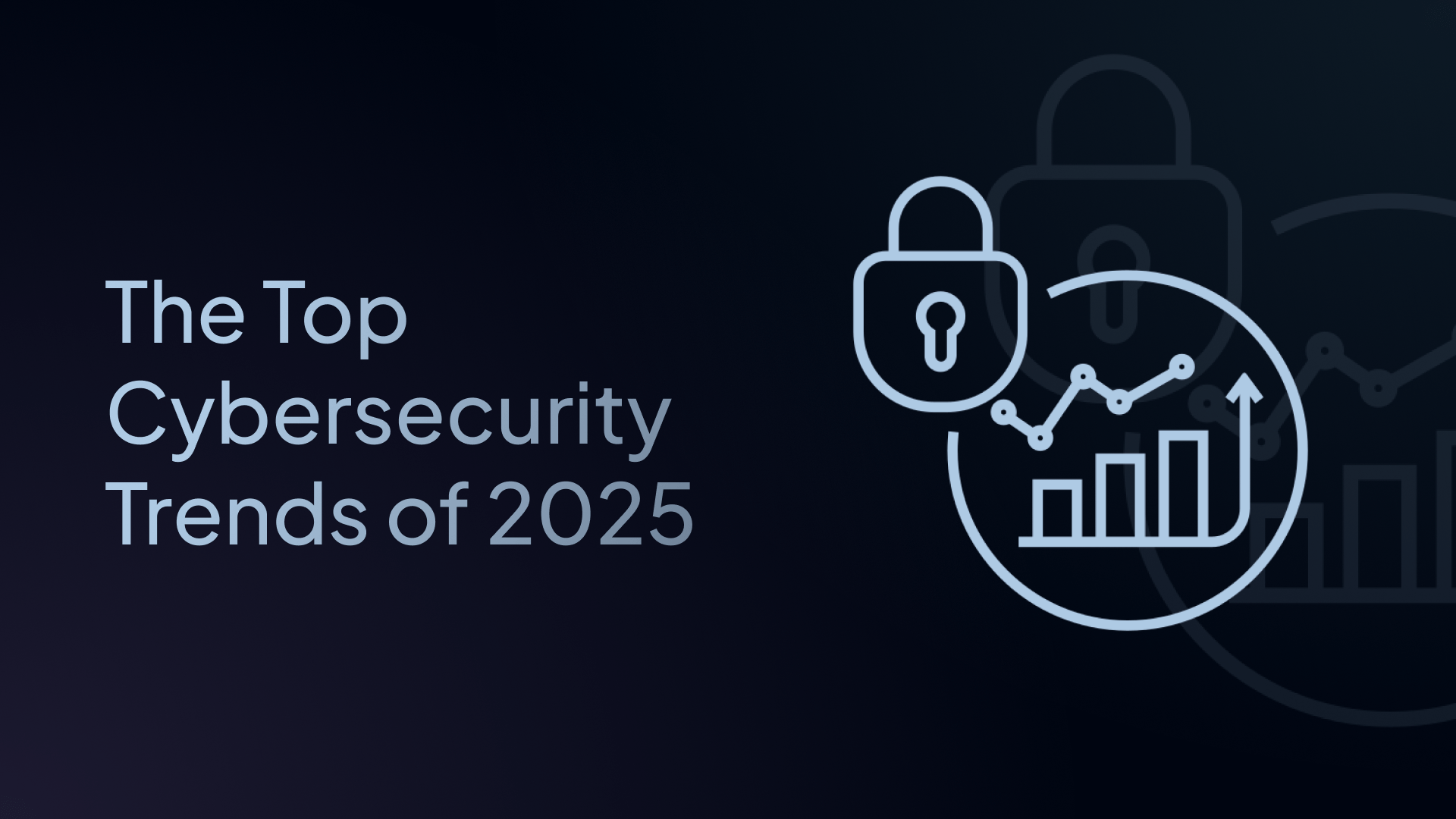The Top Cybersecurity Trends of 2025
Trust, automation, identity, and the invisible seams between cloud services, AI models, and the humans who rely on them are all important cybersecurity trends for 2025.

In 2025, cybersecurity isn't just about stolen passwords or broken firewalls. Trust, automation, identity, and the invisible seams between cloud services, AI models, and the humans who rely on them are all relevant topics.
As everything from cars to pacemakers connects to the internet, the surface area for attacks has exploded. Meanwhile, threat actors are getting smarter — not just in code, but in tactics, psychology, and scale.
This article breaks down the top cybersecurity trends shaping 2025. Whether you’re a CISO, a startup founder, or just someone trying to stay ahead of the curve, this is what you need to know — what’s coming, what’s already here, and what to stop ignoring.
1. Generative AI and Deepfakes
No surprise here: Generative AI in general, and deepfakes in particular, are at the top of everyone’s list of cybersecurity trends for 2025. Thanks to ChatGPT and other LLM-driven text-generation applications, gone are the days when you could spot a phishing email at a glance because of its poor spelling and peculiar grammar. Today’s phishing messages are slick, polished, and persuasive. Several billion email recipients around the world will need to level up their phishing awareness.
The parallel AI trend is deepfakes: audio or video messages made to appear as if they were delivered by some trusted figure. These, too, are getting harder to spot, and they are becoming easier to make. And although it might be easy to dismiss yet another Elon Musk pitch for a get-rich-quick scheme, what if the message purports to be from your boss, another coworker, or even a family member urgently requesting money?
If that weren’t enough, cybercriminals are also using AI to modify malware code in real time to avoid detection. Although cybersecurity defense tools are also increasing their use of AI to detect and counter threats, the AI arms race continues to escalate, and there will be many casualties.
2. Supply Chain Vulnerabilities
To increase operational efficiency, manufacturers are increasingly integrating their data systems with those of their suppliers. Automating these relationships through the use of electronic data interchange (EDI) removes bottlenecks and enables manufacturers to reduce raw-material inventories. These positive developments form a cornerstone of the digital transformation strategy for many businesses.
The bad news: All this integration provides an increased attack surface for cybercriminals to exploit. According to the World Economic Forum, “The increasing complexity of supply chains, coupled with a lack of visibility and oversight into the security levels of suppliers, has emerged as the leading cybersecurity risk for organizations.” When you establish these EDI connections, you often have no idea how your company’s data is being shared through these channels with unknown third parties.
When vetting a supplier, it’s no longer sufficient to check their quality and on-time delivery statistics. Now you need to audit their cybersecurity too, as well as that of their upstream partners. The tangled and often murky web of relationships creates immense opportunities for hackers.
3. Geopolitical Tensions and State-Sponsored Cyberattacks
If you have the perception that geopolitical tensions have ratcheted up in 2025, you’re not alone. Trade wars have broken out among once-friendly international trading partners. The war in Ukraine rages on. Tensions in the Middle East, Africa, and the Taiwan Strait continue to escalate.
Tariffs, bullets, and missiles are no longer the only, or even the primary, weapons in these conflicts. To an increasing extent, the arsenals of governments (not to mention extra-governmental groups such as drug cartels and terrorist organizations) now include cyberattack weapons.
State-sponsored cyberattacks, whether against the systems of rival nations or those of commercial operations, are marked by a high level of sophistication, with well-funded and well-organized teams of hackers using advanced tools. These attacks are motivated by the opportunity to disrupt or embarrass their targets rather than by financial gain.
But the damage caused by these types of cyberattacks can extend far beyond their intended targets. As the 2020 SolarWinds attack showed, a successful cyberattack can compromise millions of organizations around the world.
4. Ransomware-as-a-Service
Hacking was once a lonely avocation, a loose community of “lone wolves” acting in isolation. This model evolved into organizations operating in concert; different organizations exchanged data and techniques, but still operated independently of one another. In 2025, hacking has evolved into service models, the best known of which is “ransomware as a service” (RaaS).
In this model, RaaS providers give hackers access to sophisticated yet easy-to-use ransomware tools in exchange for a cut of the ransoms received. Individual hackers or groups no longer need to develop their malware from scratch, thereby reducing the barriers to entry and thereby increasing the incidence of ransomware attacks. Indeed, several analyses show a rise both in ransomware attacks and the number of active ransomware groups in 2025.
A successful ransomware attack can cripple an organization. Even if the ransom is paid (a practice most cybersecurity experts discourage) and the data and systems are recovered (and there’s no guarantee of this), the disruption in operations can cause irreparable harm, and some victims are forced out of business.
5. IoT/5G/Edge Security Risks
The continued wide proliferation of connected internet-of-things (IoT) devices, edge computing devices, and mobile devices in the enterprise presents new vulnerabilities for cybercriminals to exploit. Since their introduction over 10 years ago, the security of network-connected sensors, actuators, appliances, industrial machines, and building infrastructure systems has often been an afterthought at best, and this trend continues.
This effect is compounded by the fact that many such devices connect to public cellular 5G networks, rather than (or in addition to) in-house WiFi access points or Bluetooth connections. Despite its amazing advantages of high bandwidth and low latency, 5G introduces new security vulnerabilities. As Cyber Magazine notes, “5G networks present a broader attack surface due to their reliance on software-defined networking (SDN) and network function virtualisation (NFV), which introduces novel cybersecurity risks.
Furthermore, the rise in the popularity of edge computing devices–special-purpose computers that process data close to their sources rather than relying on cloud-based compute–has caused an even greater attack surface.
Maintaining security in this dispersed environment requires constant monitoring and vigilance. Device manufacturers must build security into their designs from the ground up, and customers need to keep the firmware on these devices up to date.
6. Remote/Hybrid Working Arrangements and Insider Threats
The COVID era manifested widespread uncertainty that kept people around the world in their homes and out of their offices, stores, and factories. Technology rose to the challenge, with platforms such as Zoom and Microsoft Teams enabling remote work on an unprecedented scale.
The fear of infection has largely subsided, but many companies and workers found that remote or hybrid working arrangements increased engagement and productivity. This employment model is thus more common and accepted now than before 2020.
The bad news is that such arrangements introduce new openings for cyberattacks. Employees can inadvertently misconfigure their devices or home network connections in ways that compromise security. System administrators might miss crucial security-related configuration items.
The distributed workforce, which could include full-time employees, temporary workers, and outside contractors, is potentially more prone to reduced vigilance or even willful sabotage. Businesses that support remote and hybrid work arrangements need to learn and follow best practices for protecting the wider perimeter.
7. Increasing Complexity in General
A common theme in all the trends discussed so far is the growth in complexity. Consider:
- Business applications are becoming more complex on their own and are increasingly integrated with each other in ever more-complex ways.
- The data that businesses rely on to make tactical and strategic decisions is also becoming more complex, with more sources of data that must be combined to extract meaningful information.
- Growth in the types of devices, where they are located (local, mobile, cloud), how they connect, and how they interact with each other and with users makes IT infrastructure management more complicated.
- Business processes are becoming more complex, and at the same time, more automated with less human oversight.
- Working arrangements, business relationships, government regulations, and other external factors are driving increased complexity in the business environment.
Increasing complexity is an inevitable feature in the evolution of business, but it also means more opportunities to make mistakes and more ways for cybercriminals to identify and exploit them.
8. On the Horizon: Quantum Computing
It’s not yet a realistic threat, but quantum computing is an emerging technology that can upend most existing cybersecurity tools and strategies. Because of their greater computational efficiency, quantum computers will one day be able to break encryption keys in seconds that even a modern supercomputer can’t break in thousands of years.
Quantum computers today are still in the research and development phase and are not yet capable enough for practical applications. But because of their potential to outperform “classical” computers in tasks such as weather forecasting and pharmaceutical development, lots of money is being poured into their development, and it seems only a matter of time before a practical quantum computer becomes available on the market.
It’s rumored that hacking organizations and governments are stockpiling intercepted or stolen encrypted data in the hopes they will be able to use quantum computers to break the encryption.
9. Shortage of Cybersecurity Talent
Another worrying trend, not directly related to the skills and resources available to cybercriminals, is the shortage of cybersecurity talent, both for the providers of cybersecurity tools and for the enterprises that use those tools. The growing size and complexity of the threat landscape is driving higher demand for cybersecurity professionals, but despite elevated salaries, the talent pool remains shallow.
Compounding this situation is the fact that cybersecurity is a high-stress occupation, and burnout is a common problem.
ISACA, an organization of data security and privacy professionals, recommends several strategies for developing, attracting, and retaining cybersecurity talent, including:
- Updating cybersecurity professional certification standards to be relevant to today’s threat landscape
- Rotating professionals into and out of cybersecurity roles periodically to avoid burnout
- Increased appreciation and rewards for the cybersecurity team
- Encouraging shared responsibility with security professionals, and redirecting setbacks into retrospectives and forward-looking action plans
By helping cybersecurity professionals manage their stress levels and reminding them of their value to the organization, businesses are more likely to draw new talent into the profession and keep them on the team longer.
10. User Training and Building a Security Culture
Taken together, the trends discussed here serve as a reminder that cybersecurity is everyone’s responsibility. If you touch a computer or connected device at work, you have a role to play in keeping the devices and data secure from cyberattacks. It’s not just the job of the IT or information security department.
That leads to a trend unlike the others: a positive one. More organizations around the world are recognizing the importance of cybersecurity and the risks of under-prioritizing it. These companies are building security cultures through a number of strategies, including:
- Increasing the frequency of cybersecurity refresher training, kept up to date to reflect the modern threat landscape
- Simplifying the process of reporting suspected phishing communications and other potential threats
- Automating the analysis of reported potential threats to provide fast response times
- Deploying tools that encourage year-round awareness and engagement
The user community in every organization is the last line of cyber-defense. It’s important to encourage a security culture that meets users on their level without overwhelming them with technical details.


